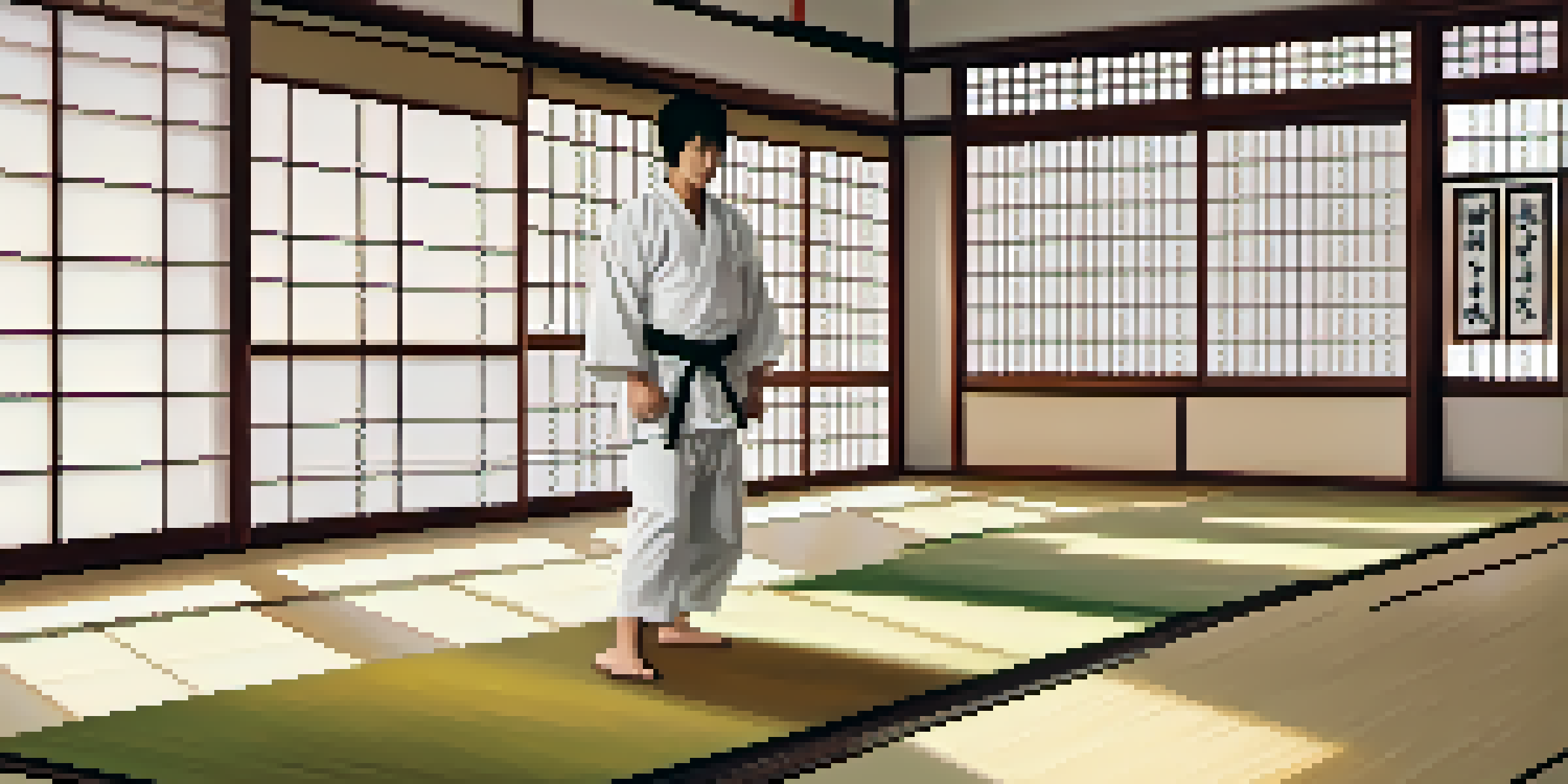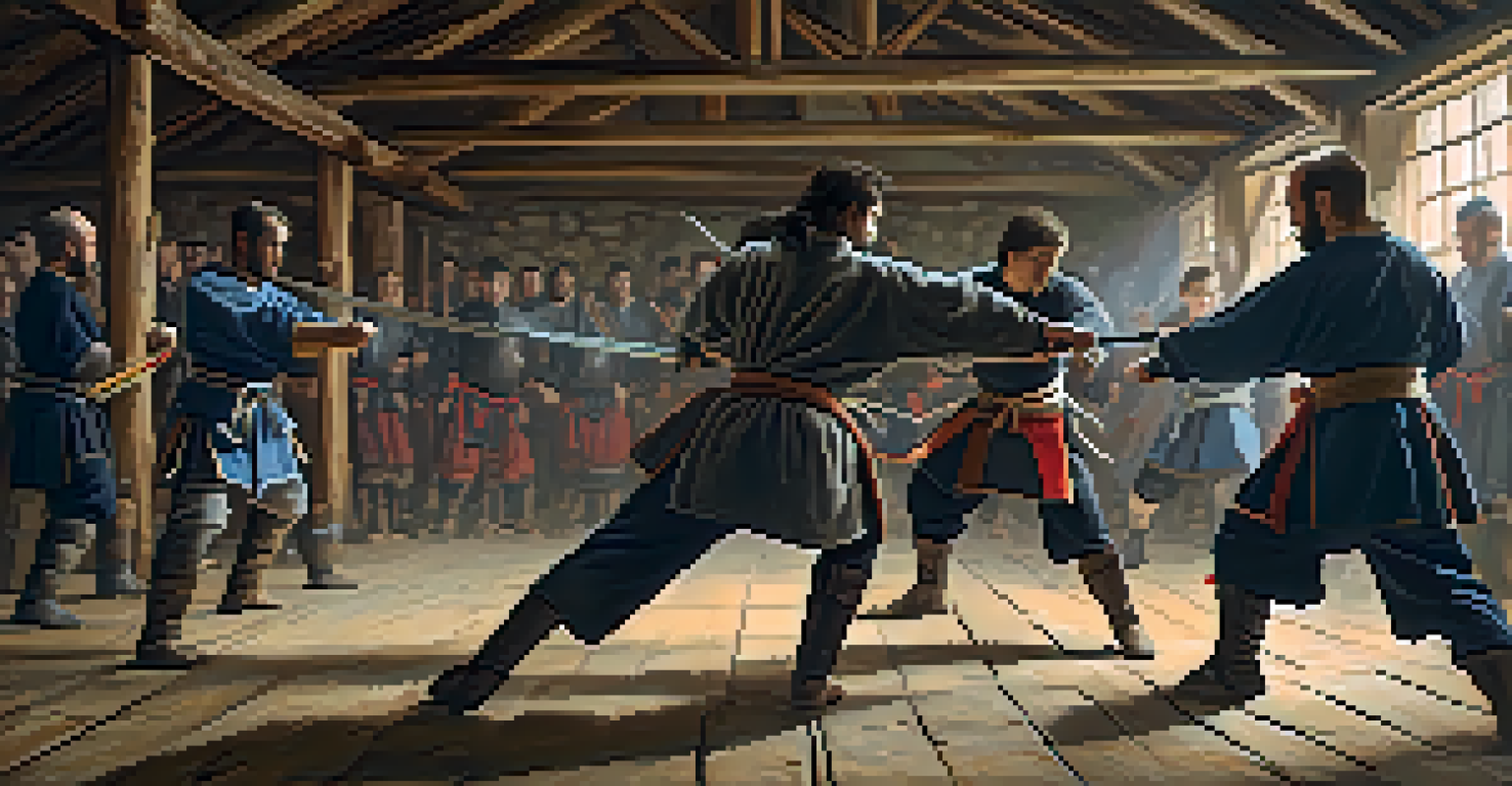Cultural Adaptations of Martial Arts Across the Globe

Understanding Martial Arts: A Global Perspective
Martial arts encompass a wide range of fighting styles and practices, each deeply rooted in its culture of origin. From the disciplined forms of Karate in Japan to the fluid movements of Capoeira in Brazil, these arts reflect the philosophies and histories of their societies. Understanding this diversity allows us to appreciate how martial arts evolve and adapt as they spread across the globe.
Martial arts is not about fighting; it's about building character.
Many martial arts began as practical fighting techniques, influenced by the social and environmental needs of their communities. For example, the ancient Greek Pankration combined elements of boxing and wrestling, reflecting the athletic culture of its time. As these styles traveled, they absorbed local customs and traditions, leading to unique adaptations that resonate with new practitioners.
In today’s interconnected world, martial arts continue to evolve, blending elements from various cultures. This cross-pollination not only enriches the martial arts themselves but also fosters greater cultural appreciation among practitioners, creating a global community united by a shared passion for these disciplines.
The Influence of Asian Cultures on Martial Arts
Asian cultures have significantly shaped the landscape of martial arts, with countries like China, Japan, and Korea at the forefront. Chinese martial arts, or Wushu, emphasize flexibility and fluidity, showcasing the philosophy of harmony with nature. Similarly, Japanese martial arts such as Judo and Aikido focus on balance and using an opponent's strength against them, reflecting the values of discipline and respect.

As these martial arts spread beyond Asia, they adapted to the local cultures they encountered. For instance, when Karate reached the United States, it evolved to incorporate elements of competition and fitness. This adaptation not only made it more accessible but also appealed to a broader audience, showcasing the flexibility of martial arts in different cultural contexts.
Martial Arts Reflect Cultural Roots
Martial arts are deeply rooted in the cultures from which they originate, embodying their philosophies and histories.
Moreover, the global fascination with Asian martial arts has led to the establishment of schools and dojos worldwide, where students learn not just the techniques but also the underlying philosophies. This cultural exchange enriches the martial arts experience, fostering a deeper understanding and appreciation for their origins.
African Martial Arts: Rich Traditions and Modern Interpretations
Africa boasts a rich tapestry of martial arts, each reflecting the continent's diverse cultures and histories. From the stick fighting of Zulu warriors to the grappling techniques of the Ethiopian sport called Genna, these practices often serve as rites of passage or community celebrations. They embody the spirit of resilience and strength found in African communities.
The true martial arts is not about defeating others; it’s about mastering oneself.
As global interest in martial arts has surged, many African styles have gained recognition and adapted to modern contexts. For instance, Capoeira, originally from Brazil, has roots in African martial traditions and has evolved into a vibrant cultural performance that combines music, dance, and acrobatics. This evolution highlights how traditional practices can adapt while maintaining their cultural significance.
Today, African martial arts are experiencing a resurgence, with practitioners seeking to reclaim their heritage and share it with the world. This revival not only honors the past but also encourages younger generations to engage with their cultural identity through physical expression and community involvement.
The Evolution of European Martial Arts Over Time
European martial arts, often overshadowed by their Asian counterparts, have a rich history that spans centuries. From the knightly combat techniques of the Middle Ages to modern sports like fencing, these practices reflect the military and social dynamics of their time. Historical European Martial Arts (HEMA) enthusiasts study ancient manuals to revive and practice these long-forgotten techniques.
As European martial arts evolved, they adapted to societal changes, such as the decline of feudalism and the rise of organized sports. Fencing, for instance, transitioned from a battlefield skill to a respected sport, complete with rules and competitions. This transformation underscores how martial arts can shift in purpose and presentation while retaining their foundational techniques.
Cultural Exchange Enriches Practices
The global spread of martial arts fosters cultural exchange, enhancing appreciation and understanding among practitioners.
In contemporary times, there's a growing interest in integrating historical techniques with modern practices. Schools and clubs are popping up across Europe, where practitioners explore both the combat and cultural aspects of martial arts. This fusion of history and modernity creates a unique training experience that celebrates both the martial and the artistic.
Latin American Martial Arts: A Blend of Heritage and Innovation
Latin America is home to a vibrant mix of martial arts, often influenced by indigenous practices, colonial histories, and African traditions. One notable example is Capoeira, a Brazilian martial art that combines dance, acrobatics, and music, rooted in the cultural expressions of enslaved Africans. This unique blend illustrates how martial arts can serve as a form of cultural resistance and identity.
As these martial arts spread, they adapted to local customs, resulting in variations that reflect the diverse experiences of practitioners. For example, the Mexican martial art of Lucha Libre incorporates theatrical elements, turning wrestling into a performance art that entertains while showcasing athleticism. This adaptability allows martial arts to resonate deeply with local communities.
Today, practitioners of Latin American martial arts are not only preserving traditional forms but also innovating new styles that blend techniques from various disciplines. This dynamic evolution fosters a sense of community and pride, showcasing the rich cultural heritage while embracing modern influences.
The Role of Martial Arts in Cultural Exchange and Understanding
Martial arts serve as a powerful medium for cultural exchange, fostering understanding and respect among practitioners from diverse backgrounds. As individuals learn techniques from different cultures, they also gain insights into the philosophies and values that underpin these practices. This exchange promotes a sense of global community rooted in shared experiences.
Many martial arts schools emphasize the importance of cultural education alongside physical training. Students not only learn how to execute techniques but also explore the historical contexts and traditions associated with their practice. This holistic approach nurtures a deeper appreciation for the art and its cultural significance.
Respecting Origins Prevents Appropriation
Understanding and respecting the cultural significance of martial arts is crucial to preventing cultural appropriation.
In competitions and seminars, martial artists from various backgrounds come together, sharing their unique perspectives and fostering friendships. These interactions create opportunities for dialogue and collaboration, breaking down cultural barriers and building connections that transcend borders.
Challenges of Cultural Appropriation in Martial Arts
As martial arts gain popularity worldwide, the issue of cultural appropriation often arises. This occurs when elements of a culture are adopted without understanding or respecting their significance. In martial arts, this can manifest when practitioners disregard the traditions and philosophies that underpin the techniques they are learning.
Cultural appropriation can lead to misunderstandings and perpetuate stereotypes, particularly when martial arts are commercialized or presented in a superficial manner. For instance, martial arts classes that prioritize profit over cultural education may dilute the rich histories of these practices, ultimately doing a disservice to their origins.

To address these challenges, it’s essential for martial artists to approach their training with respect and a willingness to learn about the cultures they are engaging with. This includes seeking guidance from experienced practitioners and acknowledging the historical context of their art. By doing so, they can help preserve the integrity of martial arts while promoting a more inclusive and respectful environment.